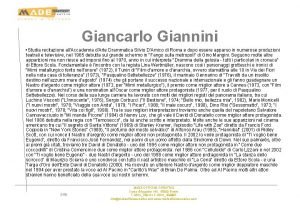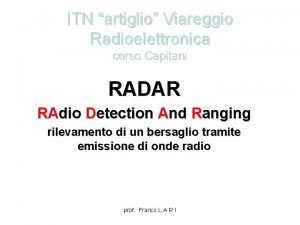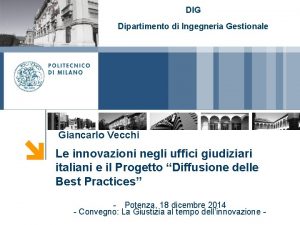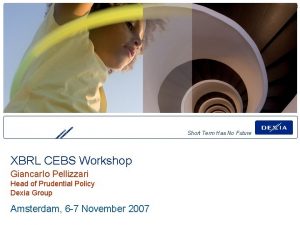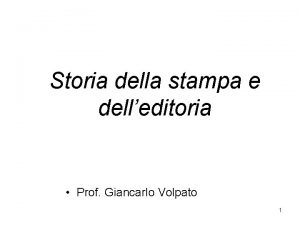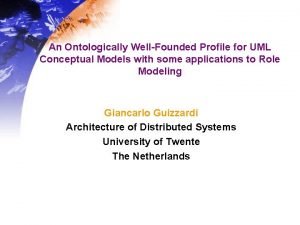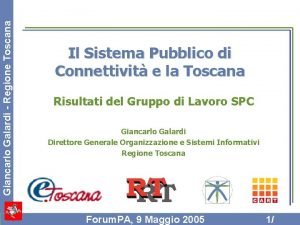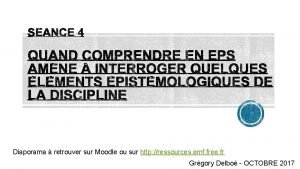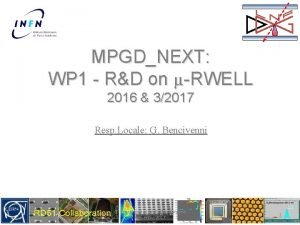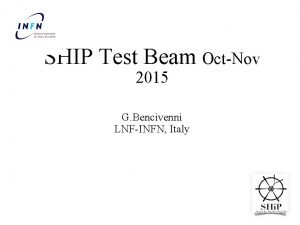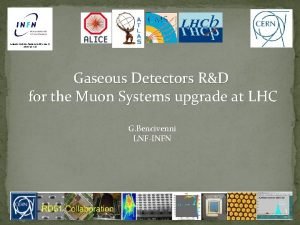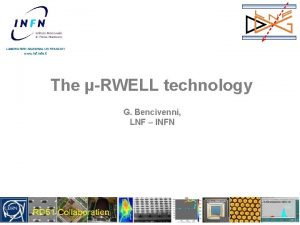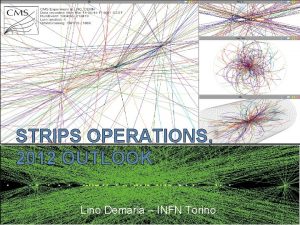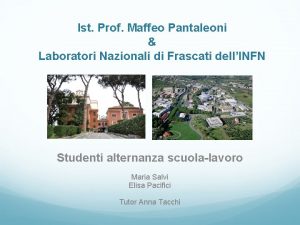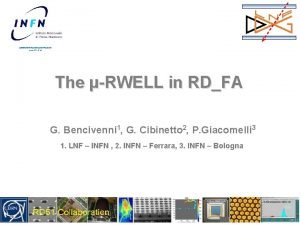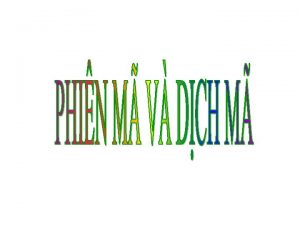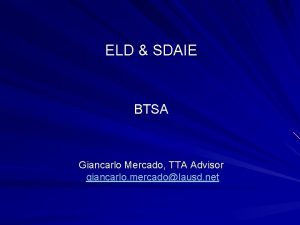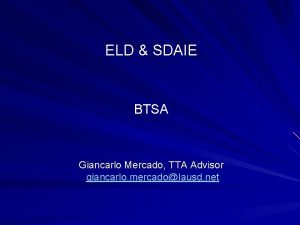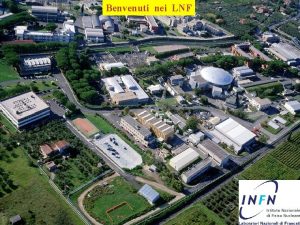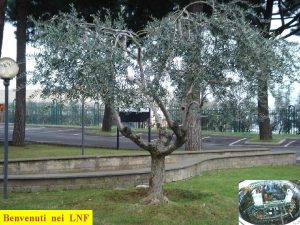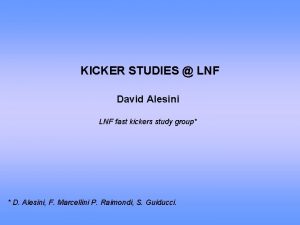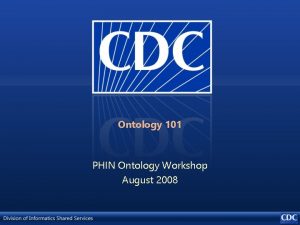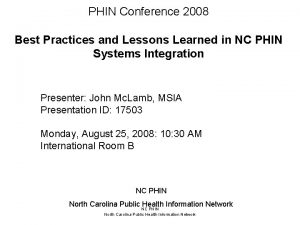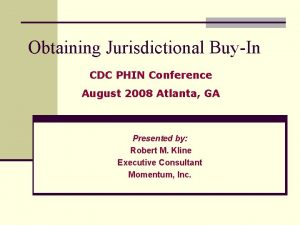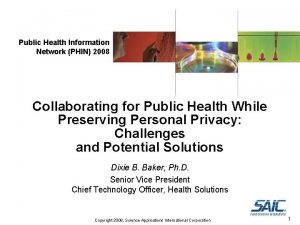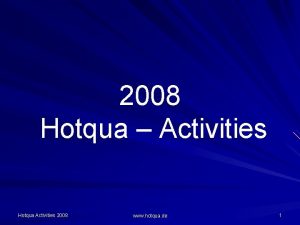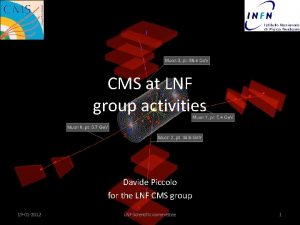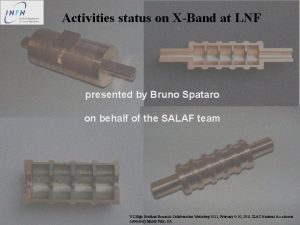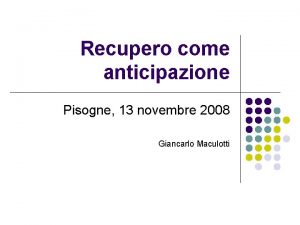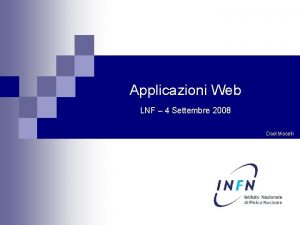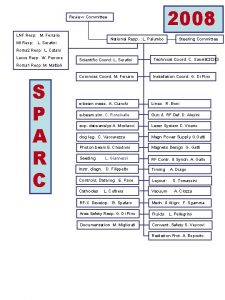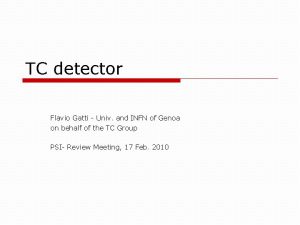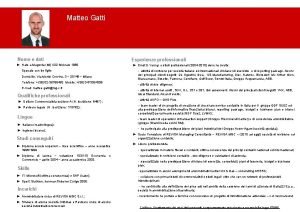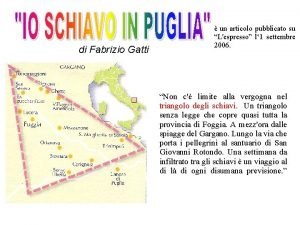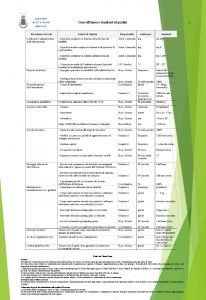Phin activities at LNF Giancarlo Gatti Care 2008


































- Slides: 34

Phin activities at LNF Giancarlo Gatti -Care 2008 CERN 2 -5 December 2008

Outline • SPARC project overview • SPARC drive laser system • IR shaper comparison for flat top laser pulse • IR/UV-pulse shaping • Laser to RF synchronization schemes • Trasverse shaping considerations • Conclusive remarks -Care 2008 CERN 2 -5 December 2008

: Mi. UR Strategic Research Programs Goals: High brightness linac to drive advanced FEL experiments And further experiments -Care 2008 CERN 2 -5 December 2008

SPARC commissioning phase 1: low energy e-beam characterization -Care 2008 CERN 2 -5 December 2008

Sparc phase 2 • After gun commissioning in 2006: -Commissioning of downstream linac in progress. -Variable gap undulators installed and ready. . . Last minute breaking news: First beam inside undulators -Care 2008 CERN 2 -5 December 2008

Photocathode drive laser Demands: Solutions: • Emittance minimization • Flexibility (Long. /Trasv. ) Uniform time and transverse laser profile: 6 -12 ps duration, rise time, 2 mm hard edge • Stable reliable operation • High current (100 A) from Cu cathode Synchronization rf laser < 1 ps rms stable laser performance High energy laser (50 -500 u. J) pulses at 266 nm -Care 2008 CERN 2 -5 December 2008

SPARC laser system: topology Ti: Sa laser composed by: time shaper • 12 nm bandwidth oscillator • IR pulse shaper • • CPA amplifiers • third harmonic generator • UV stretcher (used as shaper) • Transport to the cathode Proc. PAC 2007 TUPMN 040 -Care 2008 CERN 2 -5 December 2008

SPARC laser system pumps Pulse shaper oscillator amplifiers UV stretcher Harmonics generator • The laser delivers 5 -12 ps, 100 m. J pulses at 266 nm with a rep. rate of 10 Hz. • Energy jitter (5% rms), pointing stability (<50 mm) and synchronization respect to the RF (<2 ps rms) • Several subsystems have been integrated: IR pulse shaper, tranverse unifom pulse selection and imaging system to the cathode. -Care 2008 CERN 2 -5 December 2008

Laser temporal pulse shaping Outline: -IR shaper comparison (a. o. Filter, LCM) -Overall system performances -UV shaper M. Petrarca S. Cialdi C. Vicario -Care 2008 CERN 2 -5 December 2008

Tests of two IR pulse shapers DAZZLER From oscillator Into amplifier Half --wave Half wave plate 15 cm Telescopes Grating Dazzler Gratin g Lens From oscillator LC-SLM -Care 2008 CERN 2 -5 December 2008 Phase mask 60 cm Lens

IR programmable pulse shapers LC-SLM DAZZLER Acoustic grating Fast mode Slow mode Acousto-optic interaction in a Te. O 2 crystal -Care 2008 CERN 2 -5 December 2008

The UV time profiles the two shapers: DAZZLER LC-SLM Rise and fall time ~ 2. 6 ps Rise and fall time ~ 2. 1 ps The spectral shape after the UV stretcher is very similar to the temporal profile Opt. Lett. 31, 19 (2006) 2885 -2887 -Care 2008 CERN 2 -5 December 2008

IR shapers Features: DAZZLER LC-SLM • Compact • Not-compact • Easy alignment • Simultaneously phase & amplitude modulation • Losses within 50% • Resolution = 0. 3 nm • Slow optimization • Not easy alignment • Phase only modulation • Losses within 50% • Resolution<0. 1 nm • Fast optimization -Care 2008 CERN 2 -5 December 2008

THG distortions: main limitation for fast rise time The UV spectral shape as function of the input IR pulse length 0. 1 0. 5 1 IR pulse length [ps] Measured (solid) and simulated (dots) harmonics spectra C. Vicario et al, Opt. Lett, 31, 2006, 2885 A large enough pulse width (≥ 0. 6 ps) is needed to preserve the square spectrum throughout the THG -Care 2008 CERN 2 -5 December 2008

UV pulse shaper The UV stretcher was designed to perform several tasks 1. Lengthen the laser pulse proportional to bandwith up to 20 ps. 2. In the Fourier plane an amplitude filter, such as an iris, can be applied to cut the tails of an almost square spectrum produced bu the DAZZLER or LC-SLM, the obtained spectrum profile is transferred into the time profile by the stretcher 3. A on-line spectrometer is integrated. 3 2 1 Appl. Opt. 46, 22 (2007) 4959 -Care 2008 CERN 2 -5 December 2008

Picture of the UV shaper Filter plane Spectrom CCD Focusing lenses input output Grating pair -Care 2008 CERN 2 -5 December 2008

Cross-correlated UV profile 1 FWHM 15 ps rise time 1. 5 ps FWHM 10 ps: experim. vs simulation Simulation experiment -Care 2008 CERN 2 -5 December 2008

Measured UV profile 2 for several pulse length UV shaper allows for fast rise time despite of different chirp factors in the stretcher -Care 2008 CERN 2 -5 December 2008

Shaping without the IR filter § When a proper sharp cut is applied to the natural UV Gaussian laser spectrum, a flat top profile in time can be produced. § Results are comparable to the two stages pulse shaping. § Price to pay 20% higher energy losses § Cheaper and simpler respect to the other IR pulse shapers § The rise and fall time are reduced to ~1. 5 ps (limited by the bandwidth) -Care 2008 CERN 2 -5 December 2008

No IR shapers: simulations IR shape No IR shape spectra Time shape -Care 2008 CERN 2 -5 December 2008

Experimental results No-cut Cut applied Spectra Time Measured (red) and Simulated (black) Appl. Opt. 46, 22 (2007) 4959 -4962 -Care 2008 CERN 2 -5 December 2008

Exotic applications: UV multipeaks generation • With a grid in the fourier plane we obtained 4 peaks pulse (FEL microbunching enhancement) -Care 2008 CERN 2 -5 December 2008

Laser to RF synchronization M. Bellaveglia, S. Gallo, C. Vicario -Care 2008 CERN 2 -5 December 2008

Synchronize the laser and RF • Laser to RF synchronization is needed to have photoinjector optimal and stable operation • Photoelectron gun phase < 1 deg rms for emittance compensation • Velocity bunching, pulse compression and laser acceleration demands for a tighter specification (100 fs) Pulse selection amplification Laser oscillator Cavity length control RF chain -Care 2008 CERN 2 -5 December 2008 THG+ stretcher Measure Δf Master clock Laser to the cathode

Phase noise at oscillator level Measurements set up and results 350 fs rms -Care 2008 CERN 2 -5 December 2008

UV time jitter: measure at 10 Hz HV Photo diode Pill box cavity Laser m-wave reference mixer 0. 67 ps rms over 6 hours Phase noise detection acquisition Active feedback RF phase shifter Time of arrival jitter estimated with the RF deflector is 390 fs -Care 2008 CERN 2 -5 December 2008

Toward next step: Laser-driven RF • To reduce the time jitter we can synthesize the RF frequency from a photodiode excited by the oscillator pulses. • The value measured can be affected by the apparatus resolution, shortly more detailed characterization • This technique is applicable to lock for 1 laser system • All-optical synchronization system and clock distribution to go at sub 100 fs level -Care 2008 CERN 2 -5 December 2008

Sparc P 1 highlights Square laser at the cathode Opt. Lett. 31, (2006) 2885 Appl. Opt. 46, 22 (2007) 4959 REV. SC. INSTR. 77, 093301 2006 First ever emittance oscillation B=6*1013 A/m*rad PRL 99, 234801 (2007) PRST- AB 11, 032801 (2008) -Care 2008 CERN 2 -5 December 2008

29 E: beam experimental results • The flat top pulse shape allowed the observation of the doubleminimum emittance evolution at SPARC (only predicted by theory). current UV LASER energy 5. 5 Me. V Duration, rise time 5, 1. 5 ps rms spot size 0. 45 mm RF phase +18° PRL 99, 234801 (2007) -Care 2008 CERN 2 -5 December 2008 100 A

30 Gaussian vs flat beam: comparison -Care 2008 CERN 2 -5 December 2008

Recent advances: Trasverse shaping Main demands: -Squared beam -Power efficiency Final choice: Telescope system to map Gaussian into flat top Pros: above 70% efficiency (up to 95%) Cons: exact matching of TEM 00 gaussian alignment stability filtering cuts real efficiency 2 kinds of commercial refractive Systems probed. -Care 2008 CERN 2 -5 December 2008

INPUT BEAM Our choice: No spatial filter OUTPUT BEAM -Care 2008 CERN 2 -5 December 2008

Trasportation up to cathode Shape is preserved through relay imaging trasport (10 mt. ) -Care 2008 CERN 2 -5 December 2008

Conclusions • Extensive development on laser pulse shaping has been done at LNF -SPARC within the PHIN collaboration ▫ The two stages pulse shaping for 1. 5 ps rise time ▫ Demonstration of UV-only pulse shaping ▫ Work on faster rise time and reduced losses • Sub ps synchronization with upgrade at < 200 fs has been demonstrated • E-beam results encouraging the search of flat top pulse, definitive comparison at higher energy • Complete shaping in the next future when charge issues will be overcome. -Care 2008 CERN 2 -5 December 2008
 Bishop claudio gatti
Bishop claudio gatti Leach gatti
Leach gatti Rupert gatti
Rupert gatti 2008 2008
2008 2008 Giancarlo giannini dove vive
Giancarlo giannini dove vive Giancarlo lari artiglio
Giancarlo lari artiglio Giancarlo vecchi polimi
Giancarlo vecchi polimi Giancarlo buono
Giancarlo buono Giancarlo del corno
Giancarlo del corno Giancarlo pellizzari
Giancarlo pellizzari Giancarlo volpato
Giancarlo volpato Giancarlo gambula
Giancarlo gambula Giancarlo guizzardi
Giancarlo guizzardi Giancarlo galardi regione toscana
Giancarlo galardi regione toscana Tertiary level of care
Tertiary level of care Moodle espe lnf
Moodle espe lnf Www.lnf.infn.it
Www.lnf.infn.it Www.lnf
Www.lnf Lnf online
Lnf online National literacy and numeracy framework
National literacy and numeracy framework Www.lnf
Www.lnf Lnf.infn.it
Lnf.infn.it Infn lnf webmail
Infn lnf webmail Lnf mensa
Lnf mensa Lnf foundation phase
Lnf foundation phase Www.lnf.infn.it
Www.lnf.infn.it Health and safety care act 2008
Health and safety care act 2008 Health and social care act 2008
Health and social care act 2008 Indoor and outdoor sports list
Indoor and outdoor sports list Primary and support activities
Primary and support activities Definition of primary activities
Definition of primary activities Operating activities vs investing activities
Operating activities vs investing activities Trauma informed icebreakers
Trauma informed icebreakers Inmultirea animalelor
Inmultirea animalelor Care value base health and social care
Care value base health and social care




